Google Analytics offers so many metrics that you might wonder, on which ones should I concentrate? I have found the “Page Value” metric to be among the most powerful metrics.
Content should be at the heart of every business.
Whether you have a blog, lead generation, customer service or ecommerce site, content is always playing a key role in your business.
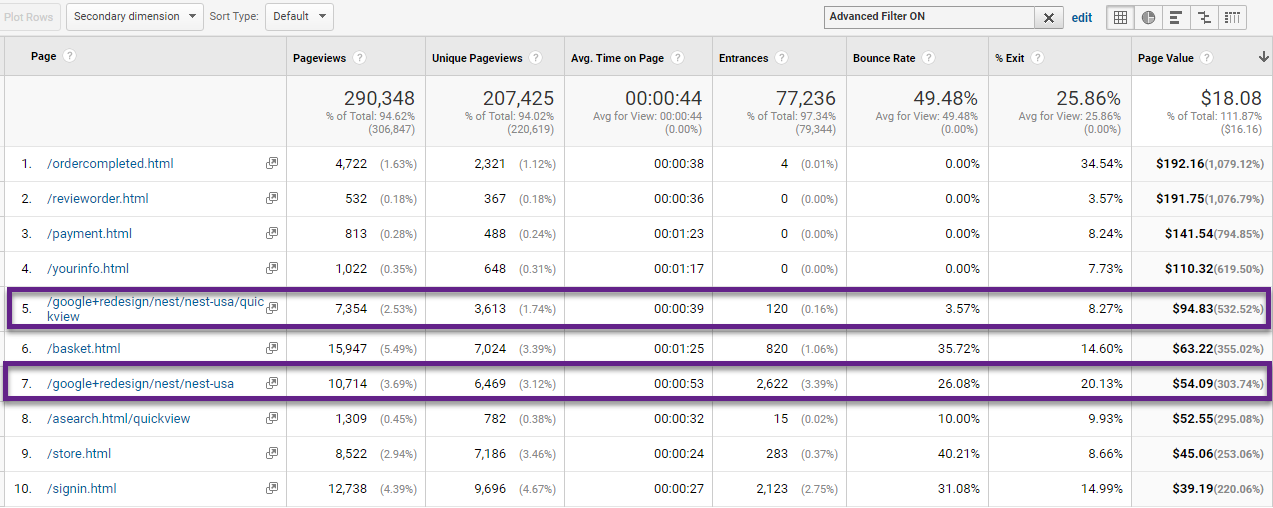
In this post you will learn all about the Page Value metric and how to leverage it when analyzing and optimizing your performance!
Table of Contents
- Introduction to Page Value
- Page Value vs Conversion Rate
- Prerequisite
- Troubleshooting
- Query Parameters
- Combine with Content Grouping
- Three Use Cases
- Concluding Thoughts
Introduction to Page Value
This is how Google describes the Page Value metric:
“Page Value is the average value for a page that a user visited before landing on the goal page or completing an Ecommerce transaction (or both). This value is intended to give you an idea of which page in your site contributed more to your site’s revenue. If the page wasn’t involved in an ecommerce transaction for your website in any way, then the Page Value for that page will be $0 since the page was never visited in a session where a transaction occurred.”
It seems like Page Value can be a key indicator of how well a page performs in a conversion cycle.
Page Value =
(Ecommerce Revenue + Total Goal Value) / Unique Pageviews for Given Page
Let’s look at an example and the math behind: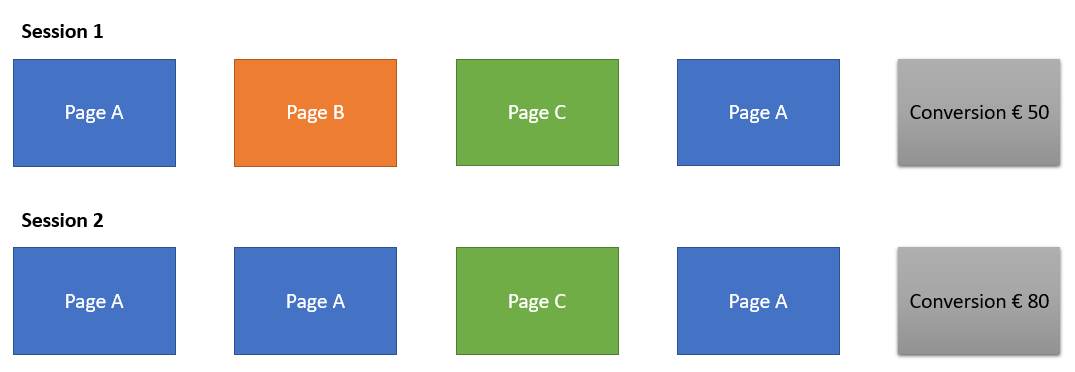
- Page A = (€ 50 + € 80) / 2 = € 65.
- Page B = € 50 / 1 = € 50.
- Page C = Page A = € 65.
I have added a third session to go in more depth:
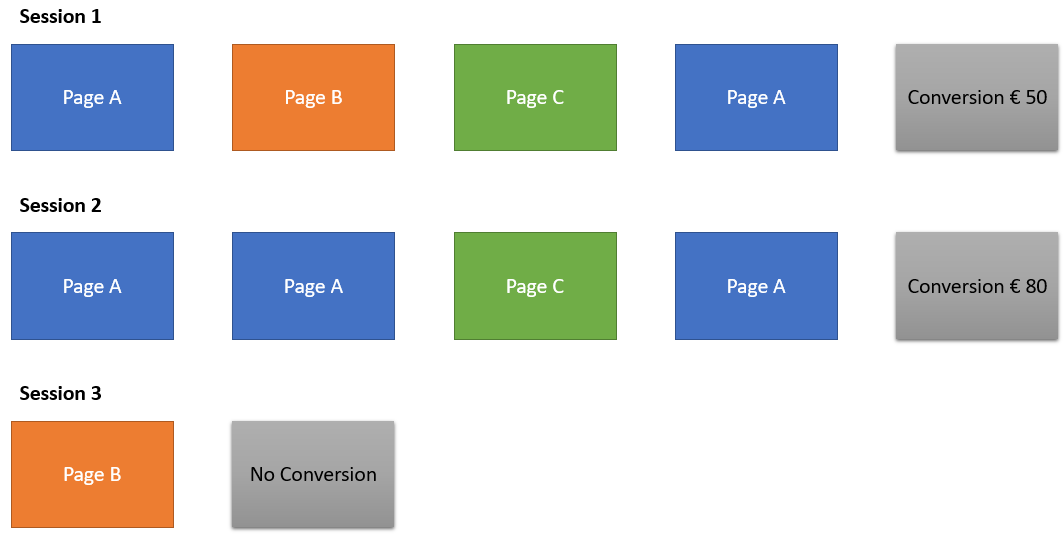 After this session, the Page Value of page B goes down:
After this session, the Page Value of page B goes down:
- Page B = € 50 / 2 = € 25.
Logically, the Page Value of pages that are close to your main conversion point (e.g. funnel steps) have a higher Page Value compared to pages further away from your main conversion point.
General rule of thumb: always look at pages with a decent amount of unique pageviews (e.g. 100) when evaluating this metric. Further, I recommend selecting at least a week or two of data when making any data analysis. And avoid holidays, promotion periods etc.
Page Value vs Conversion Rate
Conversion Rate can be a powerful metric for evaluating landing pages on your website.
However, a lot of your pages might not function as a landinge page, but still provide a ton of value in the conversion decision of your potential customers.
This is when the Conversion Rate doesn’t tell the complete story and you want to look into other metrics, like Page Value.
Further, Conversion Rate can be leveraged on many different dimensions, where Page Value (usually) is only correlated to Content dimensions.
Prerequisite
Althought it might be obvious to you, I still want to stress the importance of defining goal and/or ecommerce values in your Google Analytics view.
Your Page Value will be “zero” if you don’t define any values.
Two advanced tips:
- In one view, only use goal or ecommerce values, but not both. Usually using both will distort all value related metrics.
- Sometimes you want to set up multiple views when experimenting with Page Value. Example: one of the conversions on your website is “viewing an intro video”. You only want to set up a goal value for this conversion if you want to limit your analysis and value optimization to this conversion. Segments in Google Analytics won’t help you out here.
Troubeshooting
These are the four common reasons why you see a Page Value of zero in Google Analytics:
- You don’t have any goal or ecommerce set up in your view.
- There is no goal value attached to your configured goals.
- Your ecommerce transactions aren’t pulling in revenue metrics.
- The page(s) you are looking at didn’t contribute to a goal (with goal value) or ecommerce transaction.
Query Parameters
Query parameters can be a great pain in Google Analytics for many reasons.
Let’s take a look at the example below:
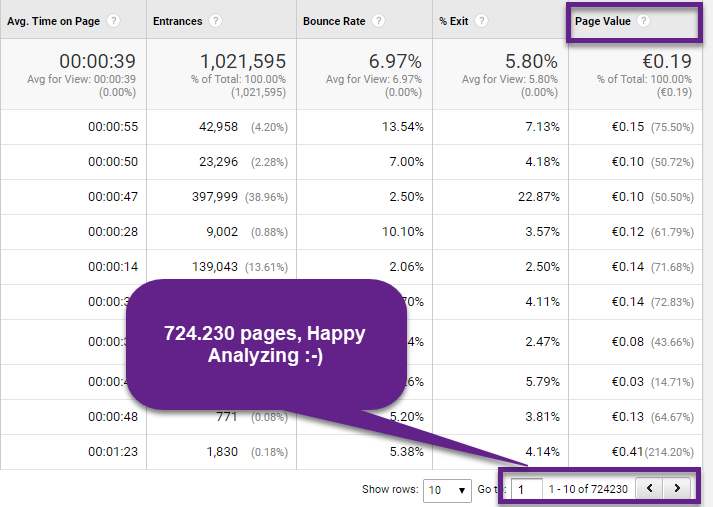
Three solutions:
- Filter one of more query parameters via the view settings.
- Remove query parameters with GTM (very helpful for PII issues in GA).
- Use one filter to remove all of them (always keep a Raw Data view).
Reading suggestion:
Combine with Content Grouping
I have written an extensive guide on Content Grouping (check it out if you haven’t yet!).
The great thing is that you can also apply Page Value metrics on a more aggregated level (Content Grouping):
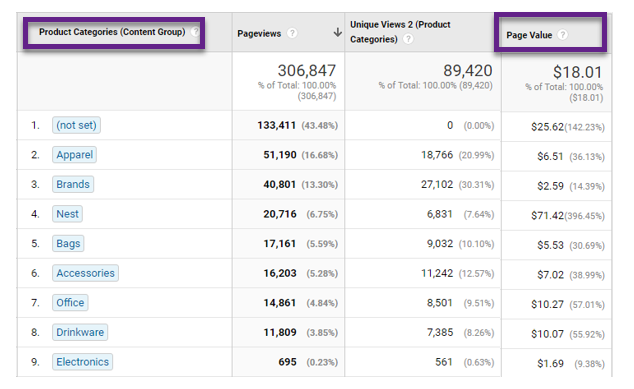 This is very helpful if you want to evaluate the value of particular sections on your website.
This is very helpful if you want to evaluate the value of particular sections on your website.
The magic doesn’t end here. You can go one step further and evaluate the Page Value of the different pages in the same content group.
 This is just one quick example of leveraging the value of combining metrics and dimensions in GA.
This is just one quick example of leveraging the value of combining metrics and dimensions in GA.
Three Use Cases
In this section you learn about three use cases for leveraging Page Value.
1. Input for A/B Testing
Analyzing the value of your webpages can deliver helpful input for A/B testing.
Quick note: remove unnecessary query parameters before making this analysis.
This metric can partly answer the question: where should I test?
A quick example:
Step 1: set up a custom report (simple report: one dimension, three metrics).
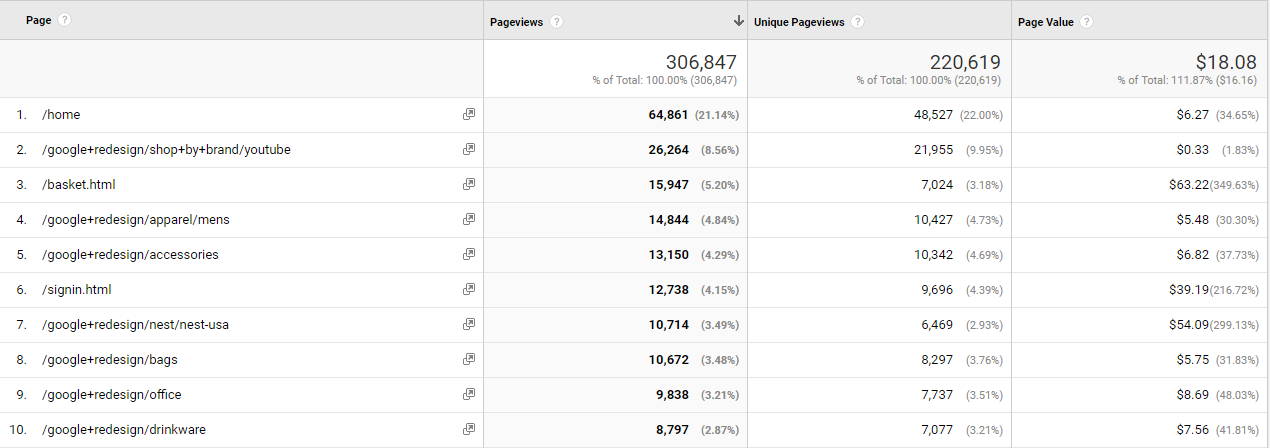
Step 2: apply a table filter to get actionable results.
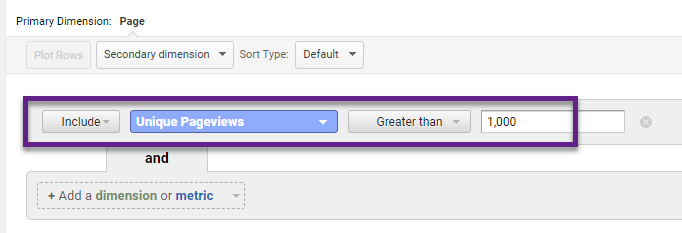 Set your own boundaries – this will ensure you are not looking at pages with just a few pageviews.
Set your own boundaries – this will ensure you are not looking at pages with just a few pageviews.
Step 3: interpret the results.
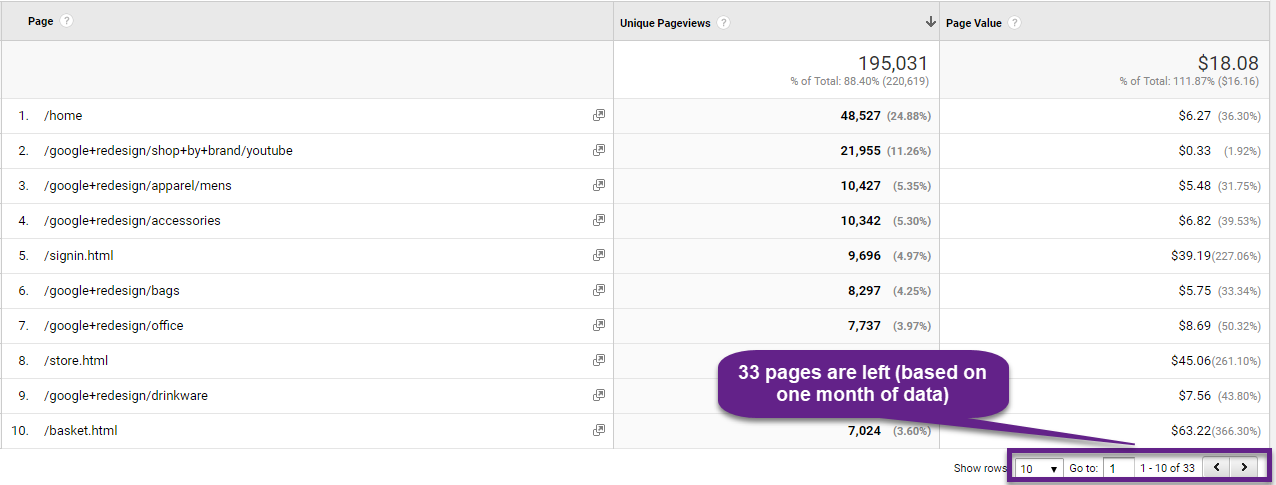 You can filter the results to learn more:
You can filter the results to learn more:
- Pages with a very low Page Value are probably not a good choice as they don’t correlate with your conversion(s).
- A page with an average value is great as you know quite a few visitors see that page before converting. Improving the page can do wonders.
- A page with a very high value is probably a page your visitors must see before converting. This could be a funnel page for example.
Your A/B testing can greatly benefit from making this analysis. Keep in mind there are several more factors that help you decide where to test.
Additional readings:
- Improve Your A/B Tests with Five Simple Questions.
- Five Steps to Effectively Analyze A/B Tests in Google Analytics.
- 10 Tips for Your Next A/B Test Report.
2. Calculate True Conversion Rate
The GA conversion rate is based on all sessions in Google Analytics, but what if:
- Your ecommerce website is accessible worldwide, but you only ship to African countries.
- Your website has a ton of customer services pages for existing client issues.
In both cases you want to modify the Conversion Rate calculation. You could do this with admin filters or segments. It all depends on your business’ unique situation.
Here is an example:
“An international ecommerce site has – in addition to their online presence – several offline stores. For facilitating visitors who want to buy online, they have a store locator page on their website.”
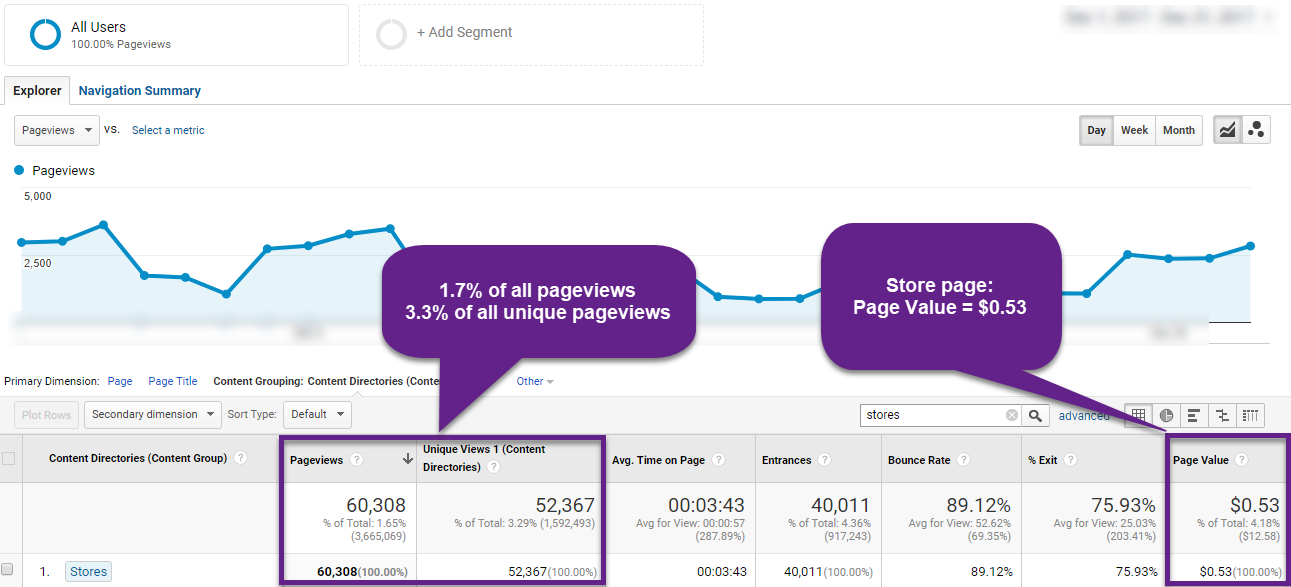
The Page Value of the store locator page is very low compared to site/page average.
You could conclude that the majority of visitors who go to this page will never convert online. They simply want to find a store to buy the product.
In terms of optimization – and Conversion Rate monitoring – you might want to exclude sessions where this page is visited.
(or you are the exception and have a perfect online/offline measuring integration set up!)
You can use a segment to get this done!
3. Structure Segments
Segmentation is the key to insights in every digital analytics tool.
Page Value can help you with setting up a few, initial segments of different visitor groups on your website.
In the last example we tried to extract a more accurate Conversion Rate and stumbled upon store locator visitors.
Here is how you could segment on this group of visitors (I use session segmentation in this example):
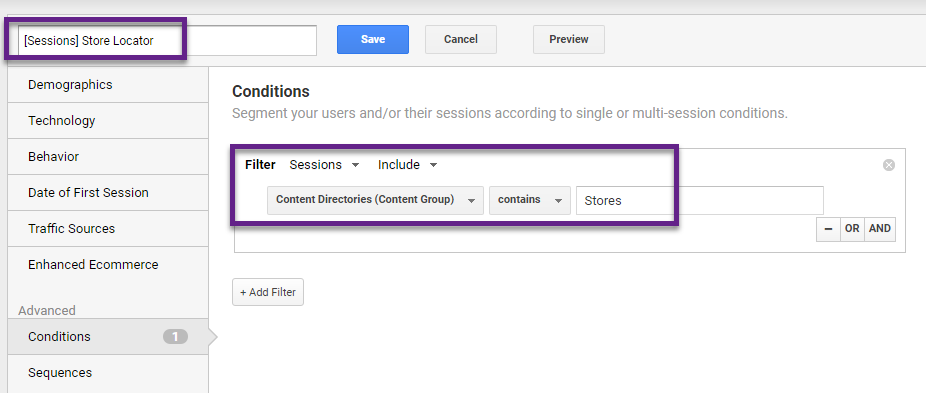
- You can focus solely on this segment by using an include statement.
- Use an exclude statement to focus on all sessions where the store locator page was not visited -> helpful segment for Conversion Rate calculation (A/B Testing).
- Whether you choose to filter on Sessions or Users depends on your exact needs and the time period you want to include in your analysis.
Concluding Thoughts
In this blogpost you have learned how one single metric can reveal such important insights. I hope you will apply these tips to your business.
A few limitations:
- Page Value is not a perfect metric (there isn’t such a thing as a perfect metric) and you should use it together with others metrics and insights you can gather.
- In terms of A/B testing, you might want to perform user metric related conversion research in addition to page metric analysis.
- The Page Value metric cannot properly be analyzed on the user level.
- Keep in mind that correlation is not the same as causation.
That being said, the Page Value metric is an excellent choice and can greatly guide your insights and optimization efforts. So make sure to start using it today!
What do you think about Page Value analysis in Google Analytics? I am looking forward to hear your thoughts and questions!
One last thing... Make sure to get my automated Google Analytics 4 Audit Tool. It contains 30 key health checks on the GA4 Setup.
Great article Paul, this is a great way of measuring engagement value as well!
Hi Lars,
Yes, for sure. This metric is very powerful in many ways.
Best,
Paul
Based on this statement above; “There is no goal value attached to your configured goals.” would it be true that you can configure your settings and set values for a particular goal and assess Page Value based on that goal rather than a revenue or monetary value???
That’s correct! The page value metric is based both on ecommerce revenue and total goal value. Google support doc: https://support.google.com/analytics/answer/2695658?hl=en.
Hello Paul,
Thanks for this great content!
I would like to ask that; what is the differences between Pages per Session, Page Depth and Pages/Session values?
Thanks for the reply.
Hi Serap,
Thanks for the heads up.
– Pages/session = page deoth
– Page Value -> please see explanation in article
Best,
Pau;
Although this article old, I really enjoyed it. Such a reasonable approach to page optimization.
Can this be achieved in GA4 too?
Unfortunately, this is not possible (at the moment) to the extent of what you could achieve in UA/GA3. You can get some insights though, something I will write about in a future post.